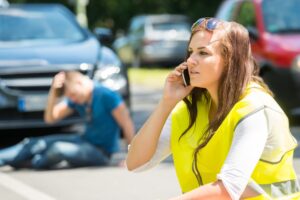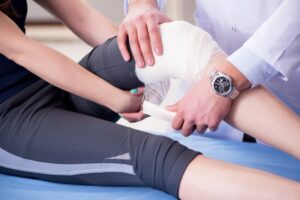Do I Need a Pedestrian Accident Attorney?
Do I Need a Pedestrian Accident Attorney?
When motorists violate traffic laws and drive recklessly – especially near traffic intersections – they may cause serious accidents with pedestrians. If a pedestrian strikes the pavement in an accident, they are likely to suffer debilitating and sometimes fatal injuries.
If you or someone you love suffered injuries in a recent pedestrian collision, an experienced pedestrian accident attorney can take the necessary legal steps. At the same time, you work on recovering from your injuries. Specifically, your lawyer can gather medical records and other documents, file a personal injury claim, and negotiate with the insurance company on your behalf. Suppose the insurance company does not make you a fair settlement offer. In that case, your attorney can explore your available litigation options and pursue a favorable result at a trial or alternative dispute resolution (ADR) proceeding.
Schedule a Free Initial Consultation
Where are Pedestrian Accidents Most Likely to Occur?
Pedestrian accidents can occur in various locations, but certain areas are more susceptible to these incidents due to pedestrian activity and traffic levels. Some of the most prevalent locations for pedestrian accidents include:

- Crosswalks and Intersections – Crosswalks at traffic intersections are frequent sites of pedestrian accidents. Drivers may neglect to yield the right-of-way to pedestrians, leading to collisions when individuals cross the street. Turning without checking for pedestrians and inattentive driving are common contributing factors.
- Residential Neighborhoods – Residential neighborhoods are also common locations for pedestrian accidents. In these areas, drivers may be less vigilant and cause accidents near driveways, intersections, or children playing near the road.
- Urban Areas and Downtowns – Urban areas with heavy pedestrian traffic, such as city centers and downtown areas, are also common locations for accidents. The mix of pedestrians, cyclists, and vehicles, coupled with crowded sidewalks and busy streets, increases the risk of these collisions.
- School Zones and Crossings – Areas around schools, especially during school drop-off and pick-up times, are common locations for pedestrian accidents. To prevent accidents, drivers must exercise extra caution in these areas.
- Parking Lots and Garages – Parking lots are areas where pedestrians and vehicles intersect frequently. Drivers backing out of parking spaces may fail to notice pedestrians, leading to collisions. Pedestrians in parking lots may also be at risk if drivers are inattentive or fail to follow proper traffic rules.
- Roads Without Sidewalks – Roads without sidewalks or inadequate pedestrian infrastructure pose risks to pedestrians. In these areas, the likelihood of accidents increases if drivers are not attentive, as individuals may walk close to or on the road.
- Transit Areas and Bus Stops – Pedestrian accidents can happen at or near bus stops and transit areas. Passengers disembarking or waiting for buses may be at risk if drivers fail to observe pedestrians in these locations. Additionally, pedestrians navigating transit areas may face challenges in traffic management.
Carefully adhering to local traffic rules and enhancing pedestrian infrastructure are essential to reducing pedestrian accidents in these common areas. Public education and responsible driver behavior play crucial roles in creating safer environments for everyone on or near the road.
Injuries in Pedestrian Accidents
Victims of pedestrian accidents can suffer a range of physical and mental injuries, often resulting in long-term consequences that significantly affect their overall well-being. Some of the most common pedestrian-accident injuries include:
- Soft tissue muscular contusions
- Broken bones
- Rib fractures
- Spinal cord and paralysis injuries
- Open cuts and lacerations
- Traumatic head and brain injuries
- Permanent cognitive impairments
- Death
Pedestrian accidents can also cause significant emotional distress, leading to post-traumatic stress disorder, or PTSD. Individuals may experience flashbacks, anxiety, nightmares, and heightened stress levels, affecting their daily lives.
Coping with the aftermath of a pedestrian accident may also lead to feelings of depression and anxiety. The physical and emotional challenges of recovery may further contribute to an accident victim’s mental health struggles.
Finally, survivors of pedestrian accidents may develop phobias and an intense fear of crossing roads or being near traffic. This fear can significantly affect their ability to resume normal activities.
Addressing the physical and mental injuries resulting from pedestrian accidents requires comprehensive medical care, rehabilitation, and mental health support. Legal assistance is also necessary to pursue compensation for the damages you suffered, ensuring you become whole again to the greatest extent possible.
Causes of Pedestrian Collisions
Pedestrian accidents often result from the negligence of motorists and others who fail to exercise due care on the road. Understanding how negligence can contribute to these accidents is crucial for promoting road safety and preventing pedestrian harm. Some of the most frequent causes of pedestrian accidents include:
- Speeding and other forms of reckless driving
- Inattentive driving
- Failing to yield the right-of-way to a pedestrian
- Fatigued driving (especially among commercial truck drivers)
- Poor vehicle maintenance
- Driving under the influence (DUI)
- Ignoring traffic signs and signals
Awareness, adherence to traffic rules, and responsible driving behavior are essential in preventing pedestrian accidents caused by negligence. If you suffered injuries in a pedestrian accident that a negligent driver caused, a personal injury lawyer can take the steps necessary to pursue a favorable settlement or litigation result.
Satisfying the Legal Burden Following a Pedestrian Accident
Meeting the legal burden of proof in a claim or lawsuit arising from a pedestrian accident is crucial for establishing liability and seeking compensation for the accident victim. Specifically, the injured accident victim must legally prove the following:
- Duty of Care – Establish that the responsible party owed a duty of care to the pedestrian. In the context of a pedestrian accident, drivers have a legal obligation to exercise reasonable care and adhere to traffic laws to avoid causing harm to pedestrians.
- Breach of Duty – Show that the responsible party breached their legal duty of care. This often involves presenting evidence of specific negligent actions, such as distracted driving, failure to yield, speeding, or other traffic violations. Eyewitness accounts, professional testimony, and traffic camera footage can support the claim by illustrating the breach of duty.
- Causation – Establish a direct link between the breach of duty and the pedestrian’s injuries. This requires demonstrating that the negligent actions were a substantial factor in causing the pedestrian accident and the subsequent harm. Medical records, diagnostic reports, and professional opinions can be pivotal in establishing the connection between the accident and the pedestrian’s claimed injuries.
- Damages include all relevant medical expenses, rehabilitation costs, lost income, pain and suffering, and any other relevant financial losses. Thorough medical records, bills, employment records, and professional testimony can help build a comprehensive case for damages.
To strengthen the legal proof, your pedestrian accident attorney can:
- Collect Witness Statements – Eyewitness accounts provide firsthand information about the accident. These statements can corroborate the sequence of events and the negligent actions of the responsible party.
- Obtain Police Reports – Police reports often include details about the accident, statements from involved parties, and the officer’s assessment of fault. Obtain a copy of the police report for evidence in your personal injury claim or lawsuit.
- Utilize Expert Testimony – Engage skilled individuals, such as accident reconstruction specialists or medical professionals, who can provide professional opinions on the cause of the accident and your resulting physical and mental injuries.
- Carefully Document Medical Records – Comprehensive medical records detail the extent of the injuries, treatment received, and future medical needs. This documentation is crucial for establishing damages in the case.
Meeting the legal burden of proof in a pedestrian accident case requires a strategic and thorough approach. A skilled personal injury attorney can guide you through the process, gather relevant evidence, and present a compelling case to establish negligence and seek fair compensation on your behalf.
Ways that a Pedestrian Accident Lawyer Can Help
Engaging a personal injury lawyer is instrumental in navigating the complexities of the legal system and seeking redress after a pedestrian accident. Here’s how a personal injury lawyer can assist individuals who have suffered injuries in a pedestrian accident:
- Legal Expertise – Personal injury lawyers focus on the laws governing personal injury claims, including those related to pedestrian accidents. Their experience ensures that clients receive accurate guidance on their legal rights and the potential avenues for compensation.
- Case Evaluation – A pedestrian accident lawyer will conduct a thorough and careful evaluation of the pedestrian accident case. This includes reviewing evidence, assessing liability, and identifying the responsible parties. A comprehensive case understanding allows the lawyer to build a strong legal strategy.
- Gathering Evidence – Personal injury lawyers are adept at gathering crucial evidence to support their clients’ claims. This may involve obtaining accident reports, collecting witness statements, analyzing traffic camera footage, and consulting with skilled accident reconstructionists if appropriate.
- Establishing Liability – Establishing legal liability is a key aspect of a pedestrian accident claim or lawsuit. A personal injury attorney will work to demonstrate that the responsible party had a duty of care, breached that duty through negligence, and directly caused the pedestrian’s injuries. This may involve presenting evidence of traffic violations, distracted driving, or other reckless behaviors.
- Negotiating with Insurance Carriers – Dealing with insurance companies can sometimes be an uphill battle. Personal injury lawyers negotiate with insurance adjusters to ensure their clients are not taken advantage of. Lawyers strive to secure fair and just compensation for economic and non-economic damages.
- Calculating the Value of the Injured Pedestrian’s Damages – Accurately calculating damages is crucial for seeking appropriate financial compensation after a pedestrian accident. Personal injury lawyers assess the full extent of their client’s losses, including medical bills, rehabilitation costs, lost earnings, pain, and suffering.
- Representation During Litigation – A personal injury lawyer is prepared to take the case to court if negotiations with insurance companies do not result in a fair settlement. They will represent their clients during legal proceedings by presenting evidence, examining and cross-examining witnesses, and advocating for their legal rights.
Engaging a knowledgeable personal injury lawyer is essential for navigating the legal complexities of pedestrian accidents. Their experience, advocacy, and commitment to their client’s well-being enhance the likelihood of a successful outcome in seeking compensation and justice for those injured in pedestrian collisions.
Types of Recoverable Damages for Pedestrian-accident Injuries
Pedestrian accident victims may be eligible to receive various economic and non-economic damages to compensate for their losses and injuries. These damages aim to address both the financial and non-financial effects of the accident:
Economic damages cover all current and future medical expenses related to the pedestrian accident. This includes hospitalization, surgeries, diagnostic tests, medications, rehabilitation, and therapy. Pedestrian accident victims may also be eligible for lost-wage compensation if their injuries prevented them from working. This includes income lost during the recovery period – or for the duration of any disability caused by the pedestrian accident. Moreover, suppose the pedestrian accident victim suffers a long-term or permanent disability that affects their ability to earn income. In that case, economic damages may be available to compensate for their loss of future earning capacity.

If personal property, such as clothing or personal belongings, suffers damage in the accident, then economic damages may also cover the cost of repair or replacement.
Non-economic damages, on the other hand, address the intangible losses resulting from the pedestrian accident. Pain and suffering compensation aims to redress the physical and emotional distress that the accident victim endured due to their injuries.
Beyond physical pain, pedestrian accident victims may experience emotional distress, anxiety, depression, or post-traumatic stress disorder (PTSD). Non-economic damages can account for the psychological effects on the victim’s overall well-being.
Similarly, suppose the pedestrian accident significantly alters the victim’s ability to engage in activities they previously enjoyed. In that case, non-economic damages may compensate for their lost quality of life. Non-economic damages may also compensate for life-altering consequences that result from a victim’s permanent injury or disability.
In cases where the pedestrian accident affects relationships, non-economic damages may address the loss of consortium, including the effect on spousal relationships, companionship, and support.
The types and amounts of damages awarded depend upon the specific circumstances of the pedestrian collision, the severity of accident-related injuries, and the resulting consequences on the victim’s life. Seeking legal advice from a personal injury lawyer is crucial to ensuring that victims receive fair compensation for their economic and non-economic losses.
Speak with a Pedestrian Accident Lawyer in Your Area Right Away

Greg Bentley, Pedestrian Accident Lawyer
If you or a person you love suffered injuries in a recent pedestrian accident, an experienced personal injury lawyer can swiftly investigate your accident circumstances, file a claim with the at-fault party’s insurance company, and pursue the financial compensation you deserve to recover.


